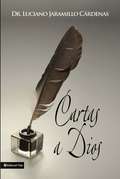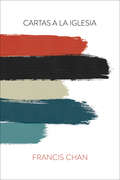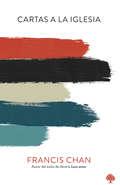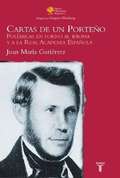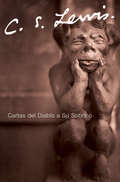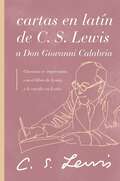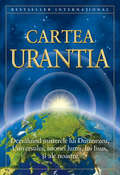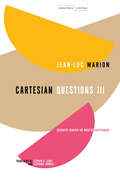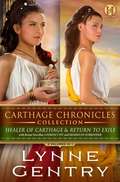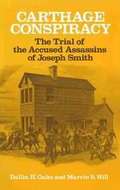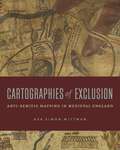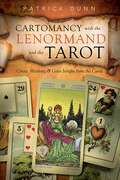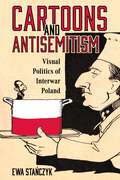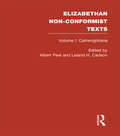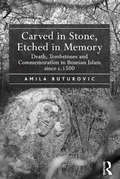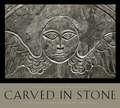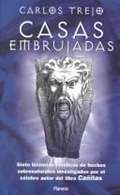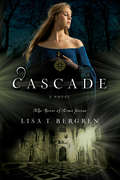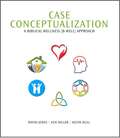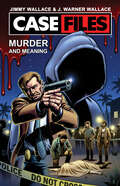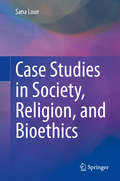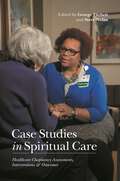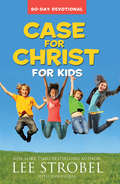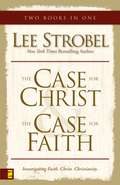- Table View
- List View
Cartas a Dios
by Luciano Jaramillo Cárdenas«Cartas a Dios viene como un anillo al dedo. En un lenguaje que combina prosa y poesía, el doctor Luciano Jaramillo Cárdenas, uno de los más notable biblistas de habla hispana, e investigador incansable en los estudios religiosos más avanzados, ha logrado combinar la solemnidad del orador con la belleza propia del lenguaje poética y de prosa elegante impecable, pero difícil de entender. En estas epístolas envía poderosos mensajes destinado lo mismo al intelectual que al lector promedio. El contenido teológico no contradice la gran inspiración que ofrecen aun a los que no se han iniciado en estos elevados y a veces inmarcesibles menesteres. Escribirle una carta a Dios tiene tanto sentido como cualquier otro ejercicio cotidiano, serio, sin embargo, poco lo han escrito con el fin de publicarlo. La oración es como una carta que enviamos al Sumo Hacedor. La divina respuesta, que llega con un buen sermón, con una buena lectura, con las palabras acertadas de un consejero, con los acontecimientos de la vida personal o de la historia colectiva, por citar solo algunos casos, la recibimos en este libro y en torno a temas importantes relacionados con una pregunta fundamental: ¿Cuál es el verdadero Cristo?»
Cartas a La Iglesia: Letters to the Church Spanish Edition
by Francis ChanEn una de sus más poderosas obras, el pastor Francis Chan profundiza en las verdades bíblicas, reflexiona sobre sus propios sueños y fracasos, y comparte historias de gente común que Dios está usando para cambiar el mundo. <p><p> Chan lo expresa diciendo: «Sabemos que nos hemos alejado de lo que Dios llama Iglesia. Sabemos que lo que experimentamos en la actualidad como Iglesia es radicalmente diferente a lo que las Escrituras relatan sobre la misma. Por décadas, líderes como yo, hemos perdido de vista el misterio intrínseco de la Iglesia. Hemos entrenado a la gente en las bancas a volverse adictos a cosas menos importantes. Es tiempo de cambio». <p> Cuando Jesús regrese, ¿nos encontrará cuidando de su novia más que a nosotros mismos?. Cartas a la Iglesia nos recuerda lo poderosa y gloriosa que fue la Iglesia en algún momento… y nos desafía a volver a ser esa Iglesia, la que Dios deseó desde el principio.
Cartas a la iglesia
by Francis ChanEn una de sus más poderosas obras, el pastor Francis Chan profundiza en las verdades bíblicas, reflexiona sobre sus propios sueños y fracasos, y comparte historias de gente común que Dios está usando para cambiar el mundo. Chan lo expresa diciendo: «Sabemos que nos hemos alejado de lo que Dios llama Iglesia. Sabemos que lo que experimentamos en la actualidad como Iglesia es radicalmente diferente a lo que las Escrituras relatan sobre la misma. Por décadas, líderes como yo, hemos perdido de vista el misterio intrínseco de la Iglesia. Hemos entrenado a la gente en las bancas a volverse adictos a cosas menos importantes. Es tiempo de cambio». Cuando Jesús regrese, ¿nos encontrará cuidando de su novia más que a nosotros mismos?. Cartas a la Iglesia nos recuerda lo poderosa y gloriosa que fue la Iglesia en algún momento… y nos desafía a volver a ser esa Iglesia, la que Dios deseó desde el principio.
Cartas de un porteño
by Juan María GutiérrezEn diciembre de 1875 Juan María Gutiérrez, notable exponente de la cultura argentina, rechaza el diploma de miembro correspondiente que le otorga la Real Academia Española. La carta en la que fundamenta su decisión, publicada en uno de los periódicos bonaerenses más influyentes de la época, sorprende al ambiente literario, porque en ella Gutiérrez pone en cuestión la naturaleza del idioma que debe utilizarse en el Río de la Plata. Sostiene que el escritor americano no debe subordinarse a legisladores de su lenguaje, porque éstos pueden convertirse en legisladores de su pensamiento, más aún cuando quien dicta las normas es la Real Academia, institución monárquica fundada, a su juicio, con fines políticos, y que pretende congelar la evolución de una lengua que desde sus orígenes se nutrió con los aportes de numerosos pueblos y culturas. Desde las páginas del semanario porteño Antón Perulero, su director, el español Juan Martínez Villergas, recoge el guante y se inicia así una de las polémicas más apasionantes de nuestras historia literaria, que bajo diversas expresiones se prolongó durante casi un siglo y medio y que aun conserva una sorprendente actualidad.
Cartas del Diablo a Su Sobrino (Boreal Ser.)
by C. S. LewisEl eterno clásico sobre "las últimas novedades del Infierno y las irrebatibles respuestas del Cielo"Esta clásica obra maestra de sátira ha entretenido e iluminado a lectores alrededor del mundo con su irónica y astuta representación de la vida y las debilidades humanas desde el punto de vista de Escrutopo, el asistente de alto rango de "Nuestro Padre de Abajo." En este divertidísimo, muy serio y excepcionalmente original libro, C. S. Lewis comparte con nosotros la correspondencia entre el viejo diablo y su sobrino Orugario, un novato demonio encargado de asegurarse de la condenación de un joven hombre.Cartas del Diablo a Su Sobrino es la historia más atractiva acerca de la tentación -- y el triunfo sobre ella -- jamás escrita.
Cartas en latín de C. S. Lewis y Don Giovanni Calabria: Un estudio sobre la amistad
by C. S. LewisAficionados de C.S Lewis disfrutaran de este gran trabajo histórico con comentarios sobre cartas entre grandes eclesiásticos en temas de divinidad, guerras, la iglesia y oraciones. En septiembre de 1947, tras leer Cartas del diablo a su sobrino, el padre Giovanni Calabria se sintió impulsado a escribirle al autor, pero no sabía inglés, de modo que lo hizo en latín. Así comenzó una correspondencia que sobreviviría al propio padre Calabria (murió en diciembre de 1954 y le sucedió en la correspondencia el padre Luigi Pedrollo).El traductor y editor Martin Moynihan califica estas cartas de &“límpidas, fluidas y profundamente refrescantes. También poseen un gran encanto, sobre todo por la forma en que se inician y concluyen, es decir, por los variopintos formalismos que se emplean para presentarlas o para despedirse&”.Las Cartas en latín de C. S. Lewis y Don Giovanni Calabria muestran, más que otras de sus publicaciones, la fuerte faceta devocional de Lewis y contienen temas que van desde la unidad de los cristianos y la historia moderna de Europa hasta la liturgia y el comportamiento ético general. Además, adquieren a menudo un carácter íntimo y personal.The Latin Letters of C.S. Lewis and Don Giovanni CalabriaFans of C.S. Lewis will enjoy this great historical work with commentaries on letters between great ecclesiastics on the subjects of divinity, war, the church and prayer. In September 1947, after reading C.S. Lewis&’s The Screwtape Letters in Italian, Fr. (now St.) Giovanni Calabria was moved to write the author, but he knew no English and assumed (rightly) that Lewis knew no Italian. So, he wrote his letter in Latin, hoping that, as a classicist, Lewis would know Latin. Therein began a correspondence that was to outlive Fr. Calabria himself (he died in December 1954, and was succeeded in correspondence by Fr. Luigi Pedrollo, which continued until Lewis&’s own death in 1963).Translator/editor Martin Moynihan calls these letters &“limpid, fluent and deeply refreshing. There was a charm about them, too, and not least in the way they were &‘topped and tailed&’ — that is, in their ever-slightly-varied formalities of address and of farewell.&”More than any other of his published works Latin Letters of C.S. Lewis and Don Giovanni Calabria shows the strong devotional side of Lewis and contains letters ranging from Christian unity and modern European history to liturgical worship and general ethical behavior.
Cartea Urantia
by Urantia FoundationCartea Urantia, publicată pentru prima dată în 1955, afirmă a fi fost prezentată de fiinţe celeste ca o revelaţie pentru planeta noastră, Urantia.Scrierile Cărţii Urantia ne învaţă despre geneza, istoria, şi destinul omenirii şi despre relaţia noastră cu Dumnezeu Tatăl. Ele prezintă o descriere unică şi provocatoare o vieţii şI învăţăturilor lui Iisus. Ele deschid spiritului uman orizonturi noi în ceea ce priveşte timpul şi eternitatea, şi oferă detalii inedite referitoare la aventura noastră ascendentă într-un univers primitor şi bine administrat.Cartea Urantia integrează clar şi concis ştiinţă, filozofie, şI religie. Cei care o citesc şi studiază cred că această carte poate influenţa semnificativ gîndirea religioasă şI filozofică a oamenilor din întreaga lume.Cartea Urantia nu este o "religie." Ea se bazează pe moştenirea religioasă din trecut şi prezent, şi încurajează o credinţă personală şi plină de viaţă.Cititorii din întreaga lume ne-au comunicat că lectura Cărţii Urantia i-a afectat în mod profund şi de multe ori le-a schimbat viaţa. I-a inspirat către un reînnoit spor spiritual şi le-a mărit capacitatea de a aprecia viaţa umană.Vă încurajăm să vă angajaţi în lectură şi să descoperiţi voi înşivă mesajul ei înălţator.
Cartesian Questions III: Descartes Beneath the Mask of Cartesianism (Cultural Memory in the Present)
by Jean-Luc MarionIn this masterful work, Jean-Luc Marion shows how some of Descartes' most decisive points remain masked by the various "Cartesianisms" that historiography and convenient simplifications alike have constructed. The book's first half shows how Descartes lines up against Cartesianism, setting forth several closely argued attempts to free up the positive status of skepticism in the Cartesian corpus, the non-substantial (and non-reflexive) character of the ego cogito, the complex elaboration of the idea of the infinite, and the role of esteem as a mode of the cogitatio. Marion then offers a second set of studies examining the work of Montaigne, Hobbes, and Spinoza and seeking to reconstitute some of the ways in which Cartesianism (and non-Cartesianism) become opposed to Descartes. Arising at the pivot point between these two paths of inquiry is a chapter dedicated to Descartes and phenomenology, with particular focus on how Descartes can be understood to have practiced—in his own way and by anticipation—a genuine phenomenological reduction. The final volume in Jean-Luc Marion's erudite trilogy of Cartesian Questions, this authoritative book demonstrates that, rather than belonging strictly to the past, Descartes continues to speak to our future.
Carthage Chronicles Collection: 2 Volumes in 1 – Healer of Carthage and Return to Exile with bonus novellas A Perfect Fit and Shades of Surrender
by Lynne GentryHealer of Carthage:<P><P> First-year resident Dr. Lisbeth Hastings is too busy to take her father’s bizarre summons seriously. But when a tragic mistake puts her career in jeopardy, answering her father’s call seems her only hope of redeeming the devastating failure that her life has become. While exploring the haunting cave at her father’s archaeological dig, Lisbeth falls through a hidden hole, awakening to find herself the object of a slave auction and the ruins of Roman Carthage inexplicably restored to a thriving metropolis. Is it possible that she’s traveled back in time, and, if so, how can she find her way back home? <P> Return to Exile:<P> Six years ago, impossible circumstances forced Dr. Lisbeth Hastings to leave behind the love of her life, not just in another country, but in another time. Her work as a top-notch epidemiologist and parenting her little girl helps alleviate the pain, but at night when her exhausted head hits the pillow, images of her beloved Cyprian haunt her sleep.<P> A Perfect Fit:<P> This prequel to The Carthage Chronicles offers an exclusive look at the romance of archaeologist Lawrence Hastings and Dr. Magdalena Kader—parents of heroine Dr. Lisbeth Hastings from the novel Healer of Carthage—and how they stumbled upon a mystery thousands of years old and began the fateful journey to the Cave of the Swimmers. <P> Shades of Surrender: This prequel to The Carthage Chronicles sheds light on the love story of Ruth and Caecilianus and the beginnings of the church in Carthage and their relationship with the young Roman noble, Cypria <P>
Carthage Conspiracy: The Trial of the Accused Assassins of Joseph Smith
by Dallin H Oaks Marvin S HillCarthage Conspiracy deals with the general problem of Mormon/non-Mormon conflict, as well as with the dramatic story of Mormon prophet Joseph Smith, his brother Hyrum, and their alleged assassins. It places the infamous event at the Carthage jail (1846) and the subsequent murder-conspiracy trial in the context of Mormon and American legal history, and deals with the question of achieving justice when crimes are politically motivated and popularly supported.
Cartographies of Exclusion: Anti-Semitic Mapping in Medieval England
by Asa Simon MittmanFrom the battles over Jerusalem to the emergence of the “Holy Land,” from legally mandated ghettos to the Edict of Expulsion, geography has long been a component of Christian-Jewish relations. Attending to world maps drawn by medieval Christian mapmakers, Cartographies of Exclusion brings us to the literal drawing board of “Christendom” and shows the creation, in real time, of a mythic state intended to dehumanize the non-Christian people it ultimately sought to displace. In his close analyses of English maps from the twelfth and thirteenth centuries, Asa Mittman makes a valuable contribution to conversations about medieval Christian perceptions of Jews and Judaism. Grounding his arguments in the history of anti-Jewish sentiment and actions rampant in twelfth- and thirteenth-century England, Mittman shows how English world maps of the period successfully Othered Jewish people by means of four primary strategies: conflating Jews with other groups; spreading libels about Jewish bodies, beliefs, and practices; associating Jews with Satan; and, most importantly, cartographically “mislocating” Jews in time and space. On maps, Jews were banished to locations and historical moments with no actual connection to Jewish populations or histories.Medieval Christian anti-Semitism is the foundation upon which modern anti-Semitism rests, and the medieval mapping of Jews was crucial to that foundation. Mittman’s thinking offers essential insights for any scholar interested in the interface of cartography, politics, and religion in premodern Europe.
Cartomancy with the Lenormand and the Tarot: Create Meaning & Gain Insight from the Cards
by Patrick DunnBeyond DivinationLooking for deeper meaning in the cards? Learn how to combine the little-known Lenormand deck with the tarot for richer, more personal readings. An expert in symbolic language, author Patrick Dunn describes how the symbolism of the Lenormand, so accessible and simple, can shine a clear light on the tarot, while the cosmology and philosophy of the tarot can lend depth and meaning to the Lenormand.Focusing on experimentation and instinct, Cartomancy with the Lenormand and the Tarot shows how to create relationships with these important divinatory systems. With personal stories, applied theory, and how-to instructions, you will discover how the symbols of the decks interact and learn how to read intuitively. Working with the Lenormand and the tarot, you can collaborate with the Universal Mind and enhance your meditative and magical work for life-changing results.
Cartoons and Antisemitism: Visual Politics of Interwar Poland
by Ewa StańczykAntisemitic caricatures had existed in Polish society since at least the mid-nineteenth century. But never had the devastating impacts of this imagery been fully realized or so blatantly apparent than on the eve of the Second World War. In Cartoons and Antisemitism: Visual Politics of Interwar Poland, scholar Ewa Stańczyk explores how illustrators conceived of Jewish people in satirical drawing and reflected on the burning political questions of the day. Incorporating hundreds of cartoons, satirical texts, and newspaper articles from the 1930s, Stańczyk investigates how a visual culture that was essentially hostile to Jews penetrated deep and wide into Polish print media. In her sensitive analysis of these sources, the first of this kind in English, the author examines how major satirical magazines intervened in the ongoing events and contributed to the racialized political climate of the time.Paying close attention to the antisemitic tropes that were both local and global, Stańczyk reflects on the role of pictorial humor in the transmission of visual antisemitism across historical and geographical borders. As she discusses the communities of artists, publishers, and political commentators who made up the visual culture of the day, Stańczyk tells a captivating story of people who served the antisemitic cause, and those who chose to oppose it.
Cartwrightiana (Routledge Library Editions Ser.)
by T CartwrightThomas Cartwright was the leader of the Elizabethan Puritans and his intellectual pre-eminence was widely acknowledged. Standard-bearer of the Prebytero-Puritans against Whitgift, he was held to have vanquished his powerful adversary by the publication of his Rest of the Second Replie (1557) Cartwrightiana is the first of 2 volumes giving authoritative editions of the works of the early Elizabethan Puritans - Cartwright, Browne and Harrison. It contains among others: accounts of Cartwright's examination before the Commissioners in 1590, Resolution of Doubts about entering the Ministry, several of his letters, A Short Catechism (1579), The Holy Exercise of a True Fast (1580) and a Preface to an Hospital for the Diseased 1959
Carved in Stone, Etched in Memory: Death, Tombstones and Commemoration in Bosnian Islam since c.1500
by Amila ButurovicDespite the recent history of violence and destruction, Bosnia-Herzegovina holds a positive place in history, marked by a continuous interweaving of different religious cultures. The most expansive period in that regard is the Ottoman rule that lasted here nearly five centuries. As many Bosnians accepted Islam, the process of Islamization took on different directions and meanings, only some of which are recorded in the official documents. This book underscores the importance of material culture, specifically gravestones, funerary inscriptions and images, in tracing and understanding more subtle changes in Bosnia’s religious landscape and the complex cultural shifts and exchange between Christianity and Islam in this area. Gravestones are seen as cultural spaces that inscribe memory, history, and heritage in addition to being texts that display, in image and word, first-hand information about the deceased. In tackling these topics and ideas, the study is situated within several contextual, theoretical, and methodological frameworks. Raising questions about religious identity, history, and memory, the study unpacks the cultural and historical value of gravestones and other funerary markers and bolsters their importance in understanding the region’s complexity and improving its visibility in global discussions around multiculturalism and religious pluralism. Drawing upon several disciplinary methods, the book has much to offer anyone looking for a better understanding of the intersection of Christianity and Islam, as well as those with an interest in death studies.
Carved in Stone: The Artistry of Early New England Gravestones
by William Gilson Thomas E. GibsonEvocative photographs and essay illuminate early American gravestones Gravestones are colonial America's earliest sculpture and they provide a unique physical link to the European people who settled here. Carved in Stone book is an elegant collection of over eighty fine duotone photographs, each a personal meditation on an old stone carving, and on New England's past, where these stones tell stories about death at sea, epidemics such as small pox, the loss of children, and a grim view of the afterlife. The essay is a graceful narrative that explores a long personal involvement with the stones and their placement in New England landscape, and attempts to trace the curious and imperfectly documented story of carvers. Brief quotes from early New England writers accompany the images, and captions provide basic information about each stone. These meditative portraits present an intimate view of figures from New England graveyards and will be enjoyed by anyone with an interest in early Americana and fine art photography.
Casa limpia o casa sólida: Una guía práctica para comprender la guerra espiritual, las fortalezas demoniacas y la liberación
by Kimberly DanielsDios desea revelarle a usted el secreto para progresar en la vida aún cuando el enemigo desearía verlo a usted bajo tierra. ¡Llegó el momento para reclamar lo que Satanás le ha robado a usted! Con la protección y la unción de Dios, usted puede entrar en el campo de batalla, examinar el lugar, batallar y salir victorioso… ¡sin mucho esfuerzo! ¡Usted puede vivir en la cima!Permítale a Kimberly Daniels mostrarle cómo deshacerse de esos problemas y esos pecados habituales hasta poder pararse espiritualmente fuerte en toda situación. Usted no tiene que vivir oprimido o adicto a toda clase de esclavitud porque ¡Jesús vino para hacerle libre! ¡La victoria es suya!A Dios le encanta ver a sus hijos triunfar sobre el enemigo… ¡en Su nombre! Permítale a Dios enseñarle su estrategia. Tome las armas dadas por Dios y aprenda a utilizarlas con confianza mientras lee este manual básico de entrenamiento para la guerra espiritual.
Casas Embrujadas
by Carlos TrejoSiete historias verídicas de hechos sobrenaturales investigados por el célebre autor del libro Cañitas.
Cascade
by Lisa T. BergrenMom touched my underdress--a gown made six hundred years before--and her eyes widened as she rubbed the raw silk between thumb and forefinger. She turned and touched Lia's gown. "Where did you get these clothes?" In Cascade, the second book in the River of Time Series, Gabi knows she's left her heart in the fourteenth century and she persuades Lia to help her to return, even though they know doing so will risk their very lives. When they arrive, weeks have passed and all of Siena longs to celebrate the heroines who turned the tide in the battle against Florence--while the Florentines will go to great lengths to see them dead. But Marcello patiently awaits, and Gabi must decide if she's willing to leave her family behind for good in order to give her heart to him forever.
Case Conceptualization: Biblical Wellness (B-Well) Approach
by David Jones Ken Miller Kevin HullCase Conceptualization: A Biblical Wellness (B-Well) Approach is developed in a stepwise progression for students and counseling practitioners. The book begins by establishing a clear understanding of wellness and then provides an overview of biblical worldview essentials. After offering these two foundations―wellness and biblical perspective―an integrated biblical wellness model is delivered, the Biblical Wellness (B-Well) model. Next, case conceptualization (CC) is addressed. It is here that you will gain an understanding of the CC process and how to use the B-Well model in that process. Finally, the last chapters deliver an application of the B-Well model by specific theory by counseling discipline―school counseling, clinical mental health counseling, addiction counseling, pastoral counseling, marriage and family counseling, and special populations―using theories such as solution-focused, cognitive behavioral, acceptance and commitment therapy, Adlerian, psychodynamic, family systems, play therapy, and others. <p><p> Case Conceptualization: A Biblical Wellness (B-Well) Approach is intended for students, counselors, counselor educators, and other helping professionals who desire to operate from wellness and a Christian worldview when conducting a clinical case conceptualization. This book seeks to offer the student, practitioner, and educator a coherent case conceptualization process by bridging the gap between wellness and a Christian worldview.
Case Files Vol. I: Murder and Meaning
by J. Warner Wallace Jimmy WallaceThis full-color, high-quality graphic novel from two law enforcement experts presents a case for a Christian worldview through an entertaining action-adventure story. Detective Michael &“Murph&” Murphy is near retirement. After twenty-five years as a sworn peace officer in Los Angeles County, he&’s wondering what will keep him busy next. He finds his mind drifting as he joins his team—with a few newbies along—to comb the cliffs of San Pedro for any clues to a recent murder there. But when a fresh murder in Palos Verdes occurs, and a mysterious subject starts calling the police department to talk to Murph, the stakes get higher. A third killing leads the team to suspect one person is behind all the murders—and still on the loose. Worse, the crimes have happened at one-week intervals, which means Murph and his colleagues have only a few days left to keep the killer from striking again …. This highly engaging, full-color graphic novel for adults is one of the first available that Christian comic book enthusiasts can feel great about reading and recommending to friends. Written by the real-life detectives and Christian apologists behind Cold-Case Christianity, and featuring art from the renowned creators of The Chosen comic book series, Case Files: Murder and Meaning has all the action and intrigue comic book readers want laced with questions about the purpose and value of human life.
Case Studies in Society, Religion, and Bioethics
by Sana LoueThis book explores, through case studies, the interplay between religion, culture, government, and politics in diverse societies on questions arising in the domain of bioethics. The case studies draw from multiple disciplinary perspectives, including history, theology, law, bioethics, public policy, science, and medicine. The text's global perspective permits a comparison of the differing approaches adopted by countries facing similar bioethical quandaries and the extent to which religion has or has not been instrumental in addressing such dilemmas. Secular and religious societies across the globe are being confronted with complex questions involving religious belief and the extent to which specific religious perspectives have in the past or should in the future be adopted as official policy. Bioethical issues involving the interplay of religion and government have become particularly notable in recent years. How these issues are resolved has major implications for individuals, healthcare providers, and the future of medical research and medical care. Topics explored among the chapters include: Homosexuality: Sin, Crime, Pathology, Identity, BehaviorMedical Error: Truthtelling, Apology, and ForgivenessRefusal of Medical TreatmentMedical Deportation Case Study: Nazism, Religion, and Human ExperimentationThe New Frontier: Cloning Case Studies in Society, Religion, and Bioethics will find an engaged audience among researchers and scholars in history, religion/theology, medicine, and bioethics interested in the influence of religion on bioethical decision-making. Students—particularly upper-level undergraduate and graduate students interested in bioethics, humanities, and theology—will find the text helpful in understanding the processes through which religion may serve as a basis for both societal policy and law and individual decision-making in health-related matters.
Case Studies in Spiritual Care: Healthcare Chaplaincy Assessments, Interventions and Outcomes
by Steve Nolan George Fitchett Andrew Todd Paul NashThrough a rich variety of case studies, this book provides insight into the patient's needs and the chaplain's perspective, as well as discussions of spiritual assessments and spiritual care interventions. Case studies such as a request to baptise a child complicated due to his admission for 'psychiatric reasons', as well as work with military veterans, such as a female transgender veteran who has been alienated from her faith, show the breadth and complexity of work that chaplains undertake daily. Each section also includes critical responses to the case studies presented from a chaplain and related healthcare professional. This book will enable chaplains to critically reflect on the spiritual care they provide, and provide an informed perspective for healthcare professionals and others involved in chaplaincy services.
Case for Christ for Kids 90-Day Devotional
by Lee Strobel Jesse FloreaBased on the eye-opening best-selling series, this 90-day devotional for kids ages 9-12 explores the life of Jesus and what it means to be a Christian, while also tackling tough questions kids ask about God. For kids who want to learn more about their faith so they can share with others, this devotional uses light-hearted prose, illustrations, historical facts, research and true stories to bring to life the miracles, ministry and way of life of Jesus.
Case for Christ/Case for Faith Compilation
by Lee StrobelWas God telling the truth when he said, 'You will seek me and find me when you seek me with all your heart'?In his #1 bestseller The Case for Christ, Lee Strobel examined the claims of Christ, reaching the hard-won verdict that Jesus is God's unique son. In The Case for Faith, Strobel turns his skills to the most persistent emotional objections to belief---the eight 'heart barriers' to faith. This Gold Medallion-winning book is for those who may be feeling attracted to Jesus but who are faced with difficult questions standing squarely in their path. For Christians, it will deepen their convictions and give them fresh confidence in discussing Christianity with even their most skeptical friends.'Everyone---seekers, doubters, fervent believers---benefits when Lee Strobel hits the road in search of answers, as he does again in The Case for Faith. In the course of his probing interviews, some of the toughest intellectual obstacles to faith fall away.'---Luis Palau'Lee Strobel has given believers and skeptics alike a gift in this book. He does not avoid seeking the most difficult questions imaginable, and refuses to provide simplistic answers that do more harm than good.'---Jerry Sittser, professor of religion, Whitworth College, and author of A Grace Disguised and The Will of God as a Way of Life
